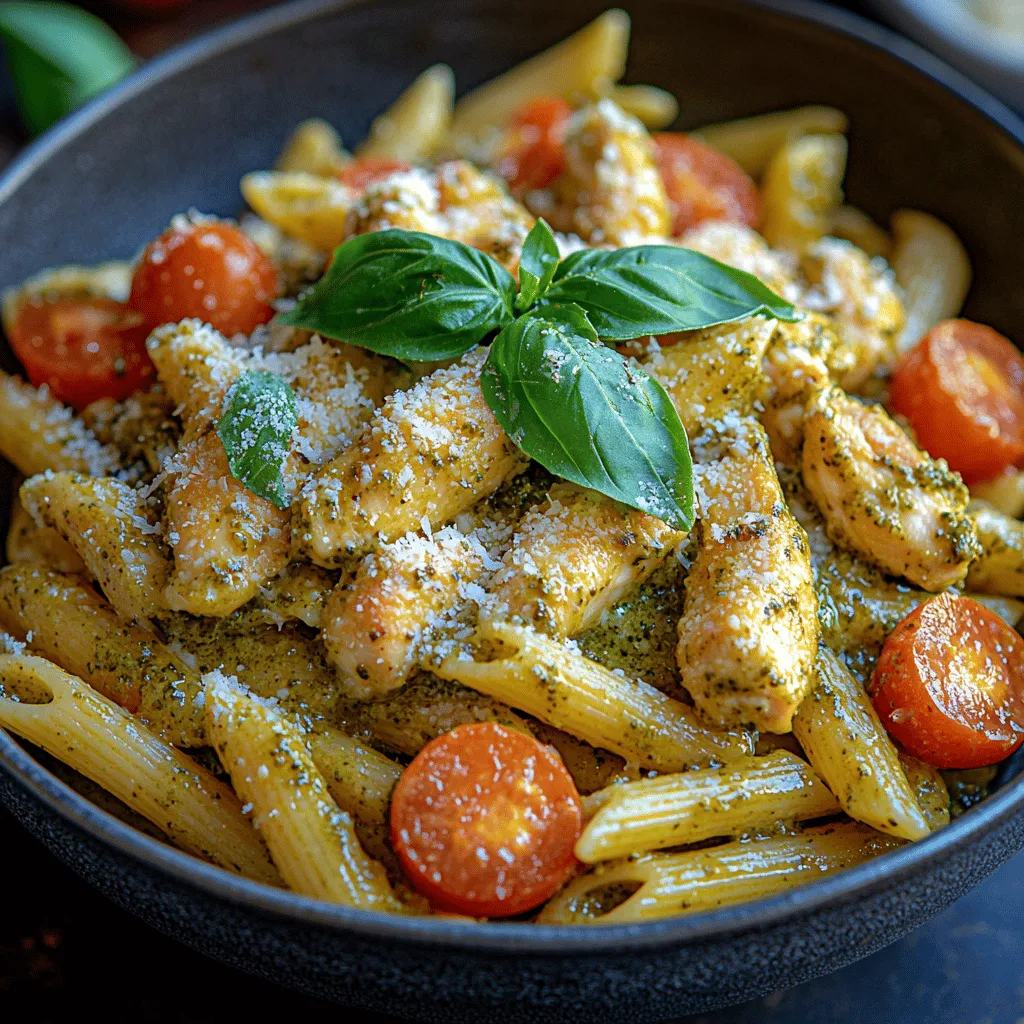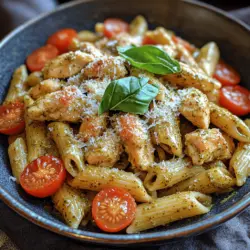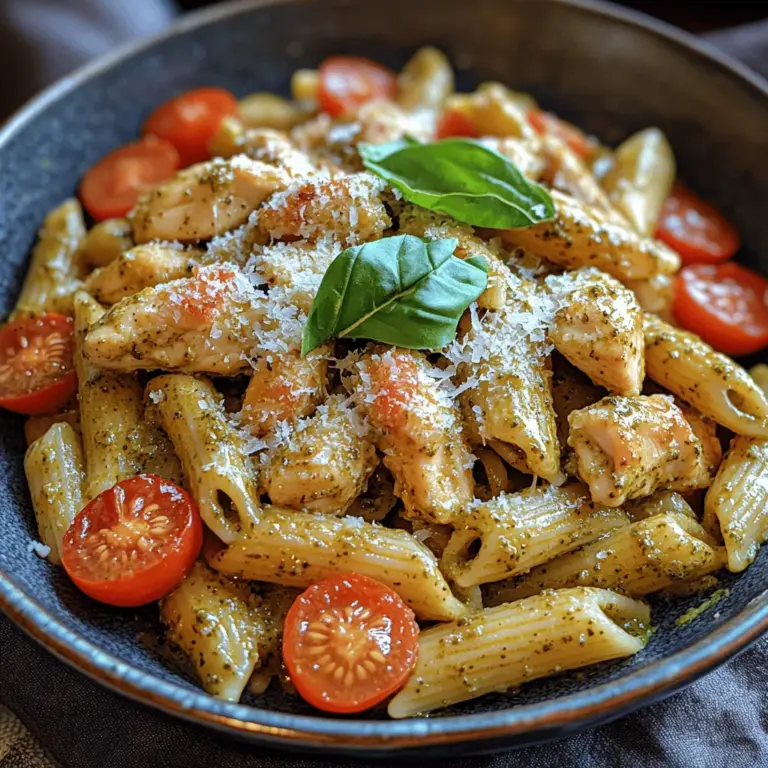Introduction to Creamy Basil Pesto Chicken Penne
When it comes to comfort food, few dishes can rival the satisfying allure of a creamy pasta. Enter Creamy Basil Pesto Chicken Penne, a dish that marries the richness of cream with the vibrant freshness of basil pesto. This delightful creation is not only a feast for the senses but also a testament to how simple ingredients can come together to create something truly special. The combination of creamy texture, herby brightness, and savory chicken makes this dish irresistible, whether you’re planning a cozy weeknight dinner or hosting a special gathering.
The appeal of Creamy Basil Pesto Chicken Penne lies in its harmonious blend of flavors. The creamy sauce envelopes the penne pasta, delivering a luscious mouthfeel that perfectly complements the aromatic basil and the slight nuttiness of the pine nuts found in the pesto. Chicken, sautéed to golden perfection, adds a hearty element that transforms this dish into a complete meal. It’s a recipe that showcases how a few quality ingredients can elevate a simple pasta dish into a culinary masterpiece.
What makes this recipe particularly appealing is its straightforward preparation. With just a handful of ingredients and minimal cooking time, you can whip up a delicious meal that tastes like it came from a fine dining restaurant. Whether you’re a busy parent looking for a quick dinner solution or someone wanting to impress guests with minimal effort, Creamy Basil Pesto Chicken Penne ticks all the boxes. Its comforting nature is sure to become a favorite in your household.
Ingredients Breakdown
To create the perfect Creamy Basil Pesto Chicken Penne, having the right ingredients is crucial. Each component plays a vital role in achieving the ultimate balance of flavors and textures. Here’s a closer look at the main ingredients:
1. Penne Pasta: This tubular pasta shape is ideal for creamy sauces because its ridges and hollow center capture the sauce beautifully, ensuring every bite is flavorful. Opting for high-quality pasta can make a noticeable difference in the final dish.
2. Chicken Breast: Tender and juicy chicken breasts provide the protein base for this dish. They absorb flavors well and complement the creamy sauce, making each mouthful satisfying.
3. Basil Pesto: Whether homemade or store-bought, pesto is the star of this dish. Fresh basil, garlic, pine nuts, and Parmesan cheese come together to create a vibrant sauce that adds depth and character. Using high-quality ingredients here, particularly fresh basil, will significantly enhance the dish’s flavor profile.
4. Heavy Cream: This rich ingredient is what gives the sauce its creamy texture. It helps to mellow the sharpness of the pesto, creating a balanced sauce that clings beautifully to the pasta.
5. Parmesan Cheese: A sprinkle of grated Parmesan adds a savory note and enhances the overall flavor of the dish. It can also be used as a garnish to elevate the presentation.
6. Olive Oil: A drizzle of high-quality olive oil not only adds richness but also aids in sautéing the chicken, contributing to its golden-brown crust.
7. Seasonings: Salt and pepper are essential for bringing all the flavors together. Freshly cracked pepper can add a touch of heat that complements the creamy sauce nicely.
While these ingredients are fundamental to the recipe, don’t hesitate to swap certain elements based on your preferences. For example, if you’re short on time, store-bought pesto can serve as a convenient alternative to homemade. However, if you have the time and inclination, making your own pesto allows for more control over flavor and freshness. You can also experiment with different types of pasta, such as fusilli or farfalle, depending on what you have on hand.
Cooking Pasta to Perfection
The first step in preparing Creamy Basil Pesto Chicken Penne is cooking the pasta, which is crucial for the overall texture of the dish. Choosing the right pasta shape is essential, especially for creamy sauces. Penne’s ability to hold onto the sauce makes it an excellent choice.
Step-by-Step Guide to Cooking Penne Pasta Al Dente
1. Bring Water to a Boil: Fill a large pot with water and add a generous amount of salt (about 1 tablespoon per 4-6 quarts of water). The salt enhances the flavor of the pasta as it cooks.
2. Add the Penne: Once the water is at a rolling boil, add the penne pasta. Stir occasionally to prevent sticking.
3. Cook Until Al Dente: Check the pasta package for cooking times, typically around 11-13 minutes for penne. Taste a piece a minute or two before the suggested time to ensure it’s cooked al dente—firm to the bite but not raw.
4. Reserve Pasta Water: Before draining the pasta, reserve about a cup of the starchy pasta water. This water can be added to the sauce later to achieve the desired consistency.
5. Drain the Pasta: Use a colander to drain the penne, shaking it gently to remove excess water. Avoid rinsing the pasta, as this washes away the starch that helps the sauce adhere.
Tips on Draining and Reserving Pasta Water
– Make it a habit to always reserve pasta water before draining; it’s a valuable tool for adjusting the sauce later.
– If you forget to save the water, you can always add a splash of regular water to the sauce, but starchy pasta water works best for achieving a creamy consistency.
Sautéing Chicken for Flavorful Depth
With the pasta cooking, it’s time to focus on the chicken, which will add a savory depth to the dish. Properly seasoning and cooking the chicken is essential for enhancing its flavor and texture.
Seasoning Chicken Before Cooking
1. Pat Dry: Start by patting the chicken breasts dry with paper towels. This helps achieve a golden-brown crust during cooking.
2. Season Generously: Season both sides of the chicken with salt and freshly cracked black pepper. You can also add garlic powder or Italian seasoning for an extra flavor boost.
Techniques for Achieving Perfectly Cooked Chicken
1. Heat the Pan: In a large skillet, heat a couple of tablespoons of olive oil over medium-high heat until shimmering.
2. Add the Chicken: Place the chicken breasts in the skillet, ensuring they are not overcrowded. This allows for even cooking.
3. Cook Until Golden Brown: Sauté the chicken for about 6-7 minutes on one side without moving it. Flip and continue cooking for another 6-7 minutes, or until the internal temperature reaches 165°F (75°C). This ensures the chicken is cooked through and safe to eat.
Cooking Times and Ensuring Chicken is Thoroughly Cooked
– The cooking time can vary based on the thickness of the chicken breasts. If they are particularly thick, you may need to cook them a few minutes longer.
– Use a meat thermometer for accuracy—this is the best way to ensure your chicken is done without overcooking it.
Once the chicken is cooked, remove it from the skillet and let it rest for a few minutes before slicing it into bite-sized pieces. This resting period allows the juices to redistribute, ensuring the chicken remains moist and tender.
Creating the Creamy Basil Pesto Sauce
With the pasta and chicken ready, it’s time to create the star of the dish—the creamy basil pesto sauce. This step is where all the flavors come together to create a luscious coating for the penne.
Explanation of the Sauce-Making Process
1. Combine Ingredients: In the same skillet used for the chicken (don’t wash it—this adds flavor), lower the heat and add the heavy cream. Stir to combine and let it warm through.
2. Incorporate the Pesto: Gradually whisk in the basil pesto, ensuring it blends well with the cream. The goal is to create a smooth, unified sauce.
3. Adjust Consistency: If the sauce is too thick, slowly add reserved pasta water until you reach the desired consistency. The starchy water not only helps with texture but also enhances flavor.
Importance of Gradually Incorporating Ingredients
When combining the heavy cream and pesto, it’s crucial to do so gradually. This prevents any clumping and ensures a smooth, creamy sauce. Whisking continuously also helps to emulsify the ingredients, creating a cohesive blend.
Benefits of Using Heavy Cream and Pesto Together
Using heavy cream alongside basil pesto serves two purposes. First, it adds a rich, velvety texture that elevates the sauce from a simple pesto to a luxurious accompaniment for your pasta. Second, the cream balances the intensity of the basil and garlic in the pesto, resulting in a harmonious flavor profile that is not overwhelming.
As you prepare the sauce, the aroma of basil will fill your kitchen, setting the stage for a delightful dining experience. With all components ready, you can look forward to assembling this delicious dish that is sure to impress.



